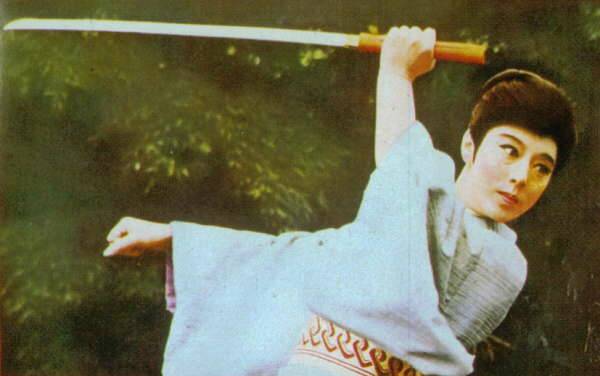 “Up to bat…”
“Up to bat…”
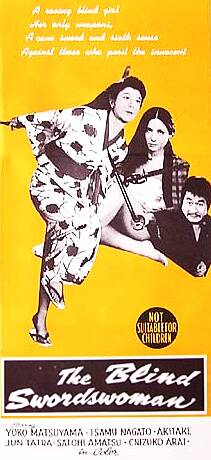 While the samurai is one of the most common archetypes in Japanese cinema, the female version is about as rare as the female gunslinger. Although none of these women reached anything like the popularity of Zatoichi – 26 films starring Shintaro Katsu alone, never mind the recent Takeshi Kitano version – there have been a few that have attempted to break the mould. Azumi and The Princess Blade have both achieved cult status in the West, assisted by Tarantino’s take in Kill Bill, Volume 1. Back in 1973, there was Lady Snowblood, which was successful enough to merit a sequel the following year, but so far, only one samurai-ess series has survived more than two outings.
While the samurai is one of the most common archetypes in Japanese cinema, the female version is about as rare as the female gunslinger. Although none of these women reached anything like the popularity of Zatoichi – 26 films starring Shintaro Katsu alone, never mind the recent Takeshi Kitano version – there have been a few that have attempted to break the mould. Azumi and The Princess Blade have both achieved cult status in the West, assisted by Tarantino’s take in Kill Bill, Volume 1. Back in 1973, there was Lady Snowblood, which was successful enough to merit a sequel the following year, but so far, only one samurai-ess series has survived more than two outings.
That swordswoman is Oichi, supposedly based on an animated story and character by Teruo Tanashita – but, really, who are they trying to kid? This was simply the Shochiku’s studio’s answer to Daiei’s Zatoichi, and any protestations to the contrary should be treated with deep scepticism. Both hero and heroine are blind, yet have no problem fighting for truth, justice and the Amer…Japanese way, as they wander through the traditional chambara landscape. [Indeed, in the first film, a blind masseuse wobbles drunkenly through one scene, in what can only be a casual potshot at Zatoichi] Original thought is not something to look for in the Crimson Bat series, even ardent fans will admit. However, Shochiku did strike gold in Yuko Matsuyama; albeit they didn’t have to look very far to find her, since she was married to character creator Tanashita. I get the feeling Shochiku didn’t exactly over-exert themselves in a star search.
With the success of Kill Bill, it seems a little strange that no-one has seen fit to give Crimson Bat proper English-language distribution. However, we don’t let things like that stop us. :-) While dubbed versions of all four films in the saga are available on the grey market, the bootleg prints seem to have Dutch, or occasionally Greek, subtitles. This lends the whole thing a certain surreal air, though as dubs go, they aren’t bad – an opinion no doubt assisted by the characters, who generally prefer to let their actions speak louder than their words. And since even Alex in Wonderland, pretty much the fount of all GWG wisdom, appears to have missed these, we’re proud to present what is (as far as I’m aware) the first review of the entire series to appear on the Internet.
[August 2005, Bill F writes: “You may be interested to learn that after the last film it was turned into a television series. The film series was produced by Shochiku. The TV series was produced by Toei. Like the films, the TV series starred Yuko Matsuyama. The TV series also starred Hiroshi Fujioka and it ran for 25 episodes (4/12/71 – 9/27/71).”]
- Crimson Bat, The Blind Swordswoman
★★★
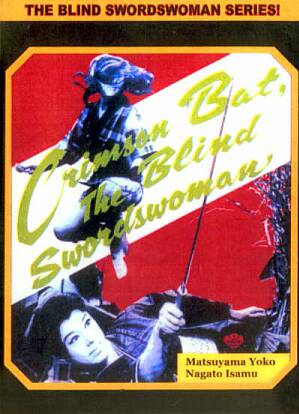 We meet our heroine Oichi as a young child, who has just been being abandoned by her mother – not sure what happened to father, but we later discover Mom’s a prostitute, so can probably fill in the blanks ourselves. To make matters worse, the tree under which Oichi takes shelter from a storm is struck by lightning, rendering her totally blind, in a way that’s – probably wisely – left medically unexplained. However, she is then taken in by a kind gentleman, who brings her up, and on into adulthood.
We meet our heroine Oichi as a young child, who has just been being abandoned by her mother – not sure what happened to father, but we later discover Mom’s a prostitute, so can probably fill in the blanks ourselves. To make matters worse, the tree under which Oichi takes shelter from a storm is struck by lightning, rendering her totally blind, in a way that’s – probably wisely – left medically unexplained. However, she is then taken in by a kind gentleman, who brings her up, and on into adulthood.She’s no luckier with her foster parent, who is murdered by a former associate, Devil Denzou (Amatsu); she is saved from the same fate by a wandering samurai. He sees her potential and trains her in the way of the sword, to the point where she has surpassed him. But she mentions the M-word – “marriage” – and he, too, exits like a, er, bat out of hell. On subsequent travels, she uses her skills to save yet another man from being lynched, and eventually, all these disparate plot threads join up, more or less. Though others, such as the woman with a killer yo-yo [GoGo Yubari’s ancestor?] just kinda drift out of the plot.
The film is at its best when there is the threat of violence; much like Sergio Leone, the lead-up lasts much longer than the actual acts, with the director ratcheting up the tension. For example, there’s one scene where Oichi visits a gambling parlour to raise money, and from the moment she sits down, you know it’s just a matter of time before her sword comes out of its red sheath (which presumably is the origin of her name – that, and the copious blood that tends to get sprayed when she’s around). There’s also a nice visual sense at work throughout here, particularly in lighting, which enhances proceedings nicely.
And, being honest, the actual drama needs all the help it can get, since it seems limp in comparison, though allowance should likely be made for the dubbing. That, however, can’t explain the bouncing back and forth in time, which may induce temporal nausea in susceptible viewers; it feels as if the finished film got tossed in the air and is shown in the order it hit the ground. And while there’s a decent “ah-hah!” when everything ties up, this isn’t enough to justify the lengthy set-up. Fewer plot threads, explored in depth, would be a major improvement.
Dir: Matsuda Teiki
Continue reading →
Star: Yoko Matsuyama, Isamu Nagato, Jun Tatara, Satoshi Amatsu
a.k.a. Mekura No Oichi Monogatari: Makkana Nagaredoni - Trapped, the Crimson Bat
★★★★

 Later that same year (1969), Oichi was back in action, and at the start of Trapped, seems quite content with her life as a bounty-huntress. She has even adopted an orphan, just as she herself was taken in herself, but two things wreck this relatively happy situation. She discovers her protege is really a runaway, not an orphan, and consequently has to abandon her – again, as she was discarded. Worse yet, she incurs the wrath of fellow bounty-huntress Oen (Matsuoka), a kitten with a whip and pockets full of venomous snakes, who leaves Oichi for dead. Luckily, she is nursed back to health by Matsuka (Irikawa), a farmer who doesn’t care about her shady past, and Oichi discovers the joys of a simpler existence – specifically, one not involving the slaughter of criminals for cash. Of course, the inevitable eventually happens: local thug Bunzo (Abe) starts taking the locals’ rice stocks, with Oen closely in tow. No prizes for guessing that the quiet life isn’t going to last long, especially after Matsuka is manipulated by Oen into owing a gambling debt to Bunzo.
Later that same year (1969), Oichi was back in action, and at the start of Trapped, seems quite content with her life as a bounty-huntress. She has even adopted an orphan, just as she herself was taken in herself, but two things wreck this relatively happy situation. She discovers her protege is really a runaway, not an orphan, and consequently has to abandon her – again, as she was discarded. Worse yet, she incurs the wrath of fellow bounty-huntress Oen (Matsuoka), a kitten with a whip and pockets full of venomous snakes, who leaves Oichi for dead. Luckily, she is nursed back to health by Matsuka (Irikawa), a farmer who doesn’t care about her shady past, and Oichi discovers the joys of a simpler existence – specifically, one not involving the slaughter of criminals for cash. Of course, the inevitable eventually happens: local thug Bunzo (Abe) starts taking the locals’ rice stocks, with Oen closely in tow. No prizes for guessing that the quiet life isn’t going to last long, especially after Matsuka is manipulated by Oen into owing a gambling debt to Bunzo.This is a fine movie, with Matusoka in particular a grand foil for the heroine, her hair covering one half of her face like a veil, and the other half usually displaying a near-psychotic expression. Oichi’s struggles to leave her past behind feel almost like Shakespearean tragedy, and the final shots of the film, while a sudden way to end, hint strongly at an endless, futile struggle. To paraphrase George Orwell, if you want a picture of the future, imagine a Samurai sword slicing up an opponent…forever. Downbeat? Hell, yes. Wouldn’t have it any other way.
The action is decent too, with Matsuyama definitely operating a step above her first outing; although these aren’t usually so much fights, more the swift dispatch of one or more opponents, that’s par for the chambara genre. Matsuka is somewhat of an enigma as a character – it’s hard to see why Oichi falls for him, and the whole “orphan” plotline is not well handled. In particular, it’s lacking any kind of background, to the extent it feels like an entire film was missing. The rest of the story though, is well-crafted and packs a solid wallop; you could certainly argue that this is the best flight of the Crimson Bat.
Dir: Matsuda Teiki
Continue reading →
Stars: Yoko Matsuyama, Yasunori Irikawa, Kikko Matsuoka, Toru Abe
a.k.a. Mekura No Oichi Monogatari: Jigoku Hada - Watch Out, Crimson Bat!
★★
 The third entry in the series saw a new director, and unfortunately, a marked turn for the worse, largely because the focus drifts off Oichi. It starts briskly enough, with the heroine coming into possession of a new, effective formula for gunpowder, something barely known at the time in Japan. Understandably, this makes her the focus of attention, in particular for a group with an interest in profiting from the discovery.
The third entry in the series saw a new director, and unfortunately, a marked turn for the worse, largely because the focus drifts off Oichi. It starts briskly enough, with the heroine coming into possession of a new, effective formula for gunpowder, something barely known at the time in Japan. Understandably, this makes her the focus of attention, in particular for a group with an interest in profiting from the discovery.I have a number of qualms with the storyline here, not least the concept that “weapons of mass destruction” (as gunpowder was, when compared to the arrows and swords prevalent during this era) are safe in any hands. Moral doubts aside, the main flaw is the introduction of characters such as Gennosuke (Ibuku) and, worse still, an immensely irritating pair of teenage orphans. Together, they succeed in making Oichi feel like a supporting character in her own movie, and she is almost entirely absent from action in the middle portion.
By the time she rides to the rescue…yes, I said “rides”, her previously unmentioned equestrian skills being hand-waved away with “the horse knows where it’s going”…the film is pretty much dead in the water. The final battle does mark another step up in scale, with Matsuyama’s skills again clearly improved, and the quantity of enemies dispatched again setting a high-water mark, even if Gennosuke gets to take out almost as many as Oichi, and the way in which the villainous henchman suddenly switches sides is laughable. In marked contrast to its two predecessors, this does have a proper ending, tying up the loose threads in a satisfying, if conventional, way. It isn’t enough to rescue the day, with interest having succumbed at a disturbingly early point.
In its incarnation as Samurai Woman (left), I believe this was the only installment to see a release in the UK. When first seen, over a decade ago, it was unimpressive, and it remains weak, particularly when viewed from an action heroine perspective. But even in general terms, it’s a poor piece of cinematic storytelling.
Dir: Hirokazu Ichimura
Continue reading →
Stars: Yoko Matsuyama, Goro Ibuki, Kiyoko Inoue, Asahi Kurizuka
a.k.a. Mekura No Oichi Monogatari: Midare Gasa - Crimson Bat: Wanted, Dead or Alive
★★★½
 Director Ichimura returned for the fourth episode, and despite similar problems as the third installment – most obviously, an apparent doubt that Oichi’s character can hold the viewer’s interest by herself – makes a much better stab at things here. Bounty-hunter Oichi finds out what life is like on the other side of the law, after she helps rescue an unwilling bride from a local magistrate; he slaps a 100 gold-piece reward on her head, which naturally, brings other bounty-hunters on her trail, led by Sankuro (Meguro).
Director Ichimura returned for the fourth episode, and despite similar problems as the third installment – most obviously, an apparent doubt that Oichi’s character can hold the viewer’s interest by herself – makes a much better stab at things here. Bounty-hunter Oichi finds out what life is like on the other side of the law, after she helps rescue an unwilling bride from a local magistrate; he slaps a 100 gold-piece reward on her head, which naturally, brings other bounty-hunters on her trail, led by Sankuro (Meguro).She ends up in a fishing village, where the “evil property developer” subplot makes a surprising appearance, despite the historical era. The reconstruction of the harbour threatens to put the locals out of work, but a plot is afoot among the local authorities to pay them only one gold piece each in compensation, rather than the 15 gold pieces actually provided by the federal government. Residents, officials, bounty-hunters and Oichi all inevitably collide, including one character played by Tetsuro Tamba, who remains even now one of the most respected (and prolific – the IMDB lists 193 films for him!) actors in Japanese cinema.
There’s a lot of devious double-crossing and deception here, which is okay to watch, but isn’t really the reason we watch these things. And that it also turns out to be Sankuro’s birthplace is too much of a fluke to swallow. Fortunately, it all builds nicely to an extended finale, where our heroine (now also framed for the murder of a village elder) gets a chance to take out her aggression and resentment on all those who have turned her life into that of a hunted animal. It’s a great urban battle, through the town which is being demolished around her, in and out of buildings until she finally confronts the chief villain of the piece.
Though this was the last entry in the series, there isn’t much sense of closure at the end, with (and I trust I’m not really spoiling this for anyone) Oichi merely walking off into the sunset, alone again, naturally. One senses Shochiku were hoping to continue, but for whatever reason – most likely box-office success, or rather, the lack thereof – it never materialised. However, for a series from the 60’s, it was undeniably ahead of its time, and most of the films have survived the passage of three and a half decades in an impressive style. If any enterprising DVD company were to snap them up, the rewards would likely be significant.
Dir: Hirokazu Ichimura
Continue reading →
Stars: Yoko Matsuyama, Yuki Meguro, Tetsuro Tanaba, Reiko Oshida
a.k.a. Mekura No Oichi Monogatari: Inochi Moraimasu





 I liked, and enjoyed the original film, and at first, this seems to have a great chance at surpassing it. The opening fight between our two heroines, one (Choi) a slave-trader, the other (Chung) an enforcer for the Empress, is a masterpiece that combines wire-work, CGI and gimmickry – camerawork from Azumi and what looks like a mutant Klingon batleth – to fabulous (if not fully convincing) effect. All this in a mythical kingdom where women rule, and men are reduced to “dumbbells”, while the cast includes both Jackie Chan and Donnie Yen. Even if the connection to the original is tenuous at best, the potential here doesn’t need to be specified.
I liked, and enjoyed the original film, and at first, this seems to have a great chance at surpassing it. The opening fight between our two heroines, one (Choi) a slave-trader, the other (Chung) an enforcer for the Empress, is a masterpiece that combines wire-work, CGI and gimmickry – camerawork from Azumi and what looks like a mutant Klingon batleth – to fabulous (if not fully convincing) effect. All this in a mythical kingdom where women rule, and men are reduced to “dumbbells”, while the cast includes both Jackie Chan and Donnie Yen. Even if the connection to the original is tenuous at best, the potential here doesn’t need to be specified. On the plus side, both Twins put in surprisingly solid performances – Choi, in particular, is much less irritating than before, though remains outshone by Chung. However, they still aren’t enough on their own to sustain a movie, despite the parade of celebrity cameos, especially when co-stars Chen and Fong are woefully short of the mark. With a $10.2 million budget, I just wish they’d spent a few more dollars on the script and some decent actors. Then, it might have lived up to the marvellous first fifteen minutes.
On the plus side, both Twins put in surprisingly solid performances – Choi, in particular, is much less irritating than before, though remains outshone by Chung. However, they still aren’t enough on their own to sustain a movie, despite the parade of celebrity cameos, especially when co-stars Chen and Fong are woefully short of the mark. With a $10.2 million budget, I just wish they’d spent a few more dollars on the script and some decent actors. Then, it might have lived up to the marvellous first fifteen minutes.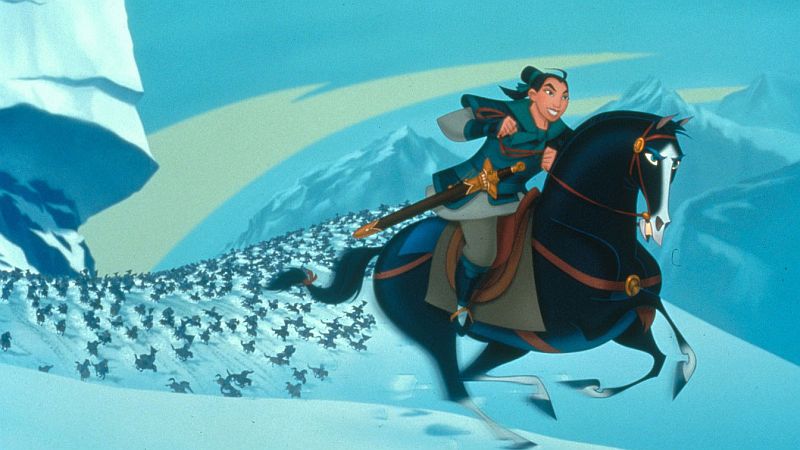
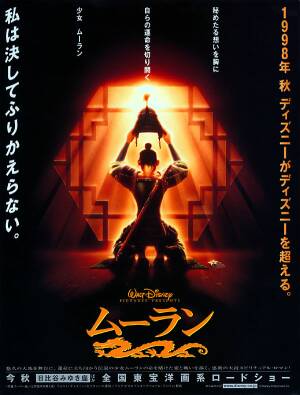 isney movies are not the usual place to find action heroines: their classic woman is a princess, who sits in a castle and waits for someone of appropriately-royal blood to come and rescue her from whatever evil fate (wicked stepmother, poisoned spinning wheel, etc.) that has befallen her.
isney movies are not the usual place to find action heroines: their classic woman is a princess, who sits in a castle and waits for someone of appropriately-royal blood to come and rescue her from whatever evil fate (wicked stepmother, poisoned spinning wheel, etc.) that has befallen her. There’s also no threat of execution when her deception is found out – Chinese culture may perhaps actually have a more tolerant approach to such things, though this is admittedly going only by the likes of Peking Opera, and a good chunk of Brigitte Lin’s career. And, of course, both the romantic angle and amusing sidekick were modern additions. This contrasts sharply with one version of the original, which has the Emperor hearing of Mulan’s exploits, and demanding she becomes his concubine. Mulan commits suicide in preference to this fate, an ending that, for some reason, didn’t make it into the Disney adaptation…
There’s also no threat of execution when her deception is found out – Chinese culture may perhaps actually have a more tolerant approach to such things, though this is admittedly going only by the likes of Peking Opera, and a good chunk of Brigitte Lin’s career. And, of course, both the romantic angle and amusing sidekick were modern additions. This contrasts sharply with one version of the original, which has the Emperor hearing of Mulan’s exploits, and demanding she becomes his concubine. Mulan commits suicide in preference to this fate, an ending that, for some reason, didn’t make it into the Disney adaptation…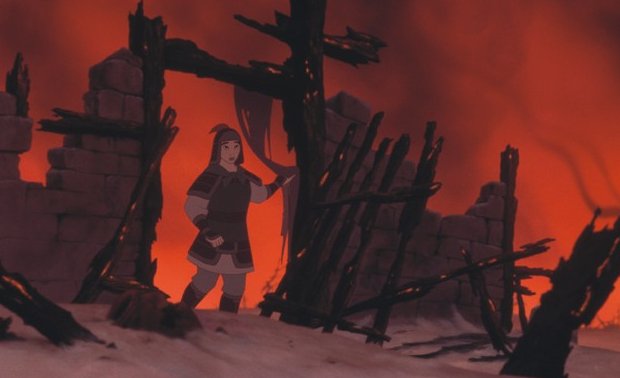 That’s a shame, because the original still has a great deal to offer. Unlike many Disney films, the songs don’t bring proceedings to a grinding halt and are notably absent from the second half of the film. Indeed, the transition is deliberately abrupt: a band of happy, singing warriors is stopped mid-verse when they come across a burnt-out village which the Huns have exterminated (right). It’s a simple, but highly effective moment, where silence says a lot more than any words. [At one point a song for Mulan about the tragedy of war was considered, but this was dropped, along with Mushu’s song, Keep ‘Em Guessing – both decisions which can only be applauded.]
That’s a shame, because the original still has a great deal to offer. Unlike many Disney films, the songs don’t bring proceedings to a grinding halt and are notably absent from the second half of the film. Indeed, the transition is deliberately abrupt: a band of happy, singing warriors is stopped mid-verse when they come across a burnt-out village which the Huns have exterminated (right). It’s a simple, but highly effective moment, where silence says a lot more than any words. [At one point a song for Mulan about the tragedy of war was considered, but this was dropped, along with Mushu’s song, Keep ‘Em Guessing – both decisions which can only be applauded.]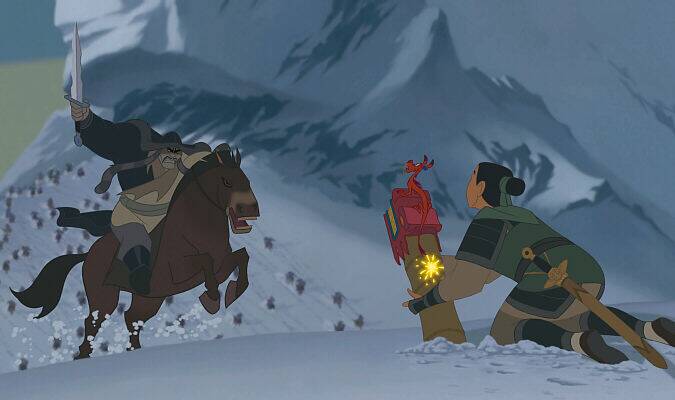 However, personally, I’d say the value of having a clearly non-Caucasian heroine (a first for any Disney film) outweighs relatively minor quibbles about subtext. It may be the last great hand-drawn animated feature from the studio which invented the genre, and all but defined it for sixty years, so I have absolutely no hesitation in recommending this as an empowering and highly entertaining tale for children – of any age, but especially those too young to read subtitles. There aren’t many action heroine films our entire family loves, but Mulan is definitely high on the list.
However, personally, I’d say the value of having a clearly non-Caucasian heroine (a first for any Disney film) outweighs relatively minor quibbles about subtext. It may be the last great hand-drawn animated feature from the studio which invented the genre, and all but defined it for sixty years, so I have absolutely no hesitation in recommending this as an empowering and highly entertaining tale for children – of any age, but especially those too young to read subtitles. There aren’t many action heroine films our entire family loves, but Mulan is definitely high on the list.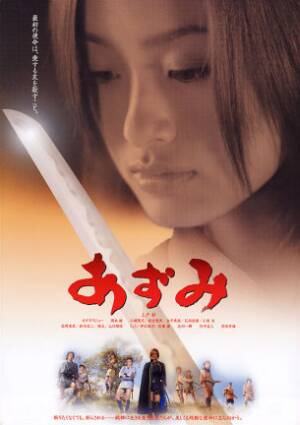
 Cutting to the chase; the action is excellent, with several sequences which would be fitting climaxes to any other movie. When you see this one’s finale, you’ll realise why they’re not: Azumi’s master is captured, and an entire town of sword-wielding rogues and assorted scum is in her way, plus villain #1, a rose-wielding psychopath who dresses in white (Odagiri). Settle back, and pass the popcorn. While the swordplay itself is mostly nothing special (save one Very Special decapitation), Kitamura captures it beautifully, the visual highlight being a full circle around two characters – vertically. The sound is also fabulous; you could close your eyes and just listen to the battles.
Cutting to the chase; the action is excellent, with several sequences which would be fitting climaxes to any other movie. When you see this one’s finale, you’ll realise why they’re not: Azumi’s master is captured, and an entire town of sword-wielding rogues and assorted scum is in her way, plus villain #1, a rose-wielding psychopath who dresses in white (Odagiri). Settle back, and pass the popcorn. While the swordplay itself is mostly nothing special (save one Very Special decapitation), Kitamura captures it beautifully, the visual highlight being a full circle around two characters – vertically. The sound is also fabulous; you could close your eyes and just listen to the battles. I used to be a Xena fan; for the first couple of series, I was a die-hard, never missed an episode, bought the merchandise, went to the gatherings, etc. I loved (with one exception) the supporting cast – Joxer, Ares, Autolycus – and still reckon Callisto remains one of the great TV villainesses of all time.
I used to be a Xena fan; for the first couple of series, I was a die-hard, never missed an episode, bought the merchandise, went to the gatherings, etc. I loved (with one exception) the supporting cast – Joxer, Ares, Autolycus – and still reckon Callisto remains one of the great TV villainesses of all time.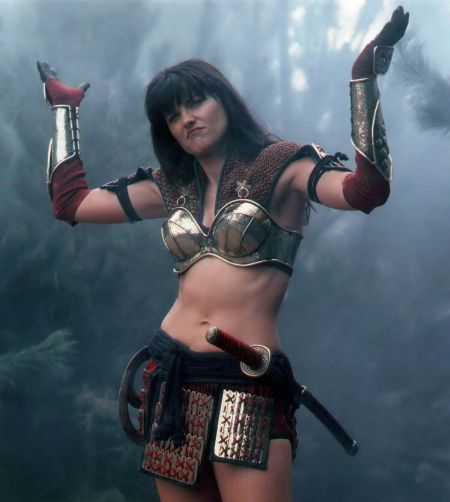
 The defining moment of Xena’s sophomore season didn’t take place in any episode. In fact, it didn’t even take place in New Zealand, but thousands of miles away, During a rehearsal for an appearance on The Tonight show with Jay Leno, Lucy Lawless was thrown off a horse after it lost its footing, and broke her pelvis. It’s interesting to compare the reaction of the producers to what the Tapert/Raimi team did when the star of Spartacus, Andy Whitfield, was similarly a victim of severe misfortune, more than a decade later. There, they put the show entirely on hold and opted instead to film a prequel without him.
The defining moment of Xena’s sophomore season didn’t take place in any episode. In fact, it didn’t even take place in New Zealand, but thousands of miles away, During a rehearsal for an appearance on The Tonight show with Jay Leno, Lucy Lawless was thrown off a horse after it lost its footing, and broke her pelvis. It’s interesting to compare the reaction of the producers to what the Tapert/Raimi team did when the star of Spartacus, Andy Whitfield, was similarly a victim of severe misfortune, more than a decade later. There, they put the show entirely on hold and opted instead to film a prequel without him. In terms of style and approach, the show covers even more ground here than the first time, from absolutely froth to grim darkness. Xena even gets crucified by Julius Caesar in one episode [confusingly, the actor responsible also crops up later, playing Cupid, complete with fluffy wings…]. I’m sure I’m not the only one who found themselves whistling Always Look on the Bright Side of Life, during the scene shown above right. Another unwitting Python reference is the wretched Here She Comss, Miss Amphipolis, a dreadful tale of drag-queen empowerment, featuring perhaps the least convincing female impersonator since John Cleese put on a dress – as on the left, watch that Adam’s apple
In terms of style and approach, the show covers even more ground here than the first time, from absolutely froth to grim darkness. Xena even gets crucified by Julius Caesar in one episode [confusingly, the actor responsible also crops up later, playing Cupid, complete with fluffy wings…]. I’m sure I’m not the only one who found themselves whistling Always Look on the Bright Side of Life, during the scene shown above right. Another unwitting Python reference is the wretched Here She Comss, Miss Amphipolis, a dreadful tale of drag-queen empowerment, featuring perhaps the least convincing female impersonator since John Cleese put on a dress – as on the left, watch that Adam’s apple  It’s assumed viewers are at least somewhat familiar with Xena’s background, as she is first seen burying her armour in an effort to bury her past. Of course, this is about as successful as it usually is in fiction, and it’s not long before she’s saving villagers, including Gabrielle, from slavery. That includes an aerial battle atop platforms, which is the first sign of the show’s strong influence from Hong Kong action films; it was using wirework, in a way that predated its popular arrival in Hollywood. Similarly, the stunning New Zealand locations foreshadow Lord of the Rings, to the extent that I kept expecting to see hobbits gamboling along in Xena’s wake.
It’s assumed viewers are at least somewhat familiar with Xena’s background, as she is first seen burying her armour in an effort to bury her past. Of course, this is about as successful as it usually is in fiction, and it’s not long before she’s saving villagers, including Gabrielle, from slavery. That includes an aerial battle atop platforms, which is the first sign of the show’s strong influence from Hong Kong action films; it was using wirework, in a way that predated its popular arrival in Hollywood. Similarly, the stunning New Zealand locations foreshadow Lord of the Rings, to the extent that I kept expecting to see hobbits gamboling along in Xena’s wake.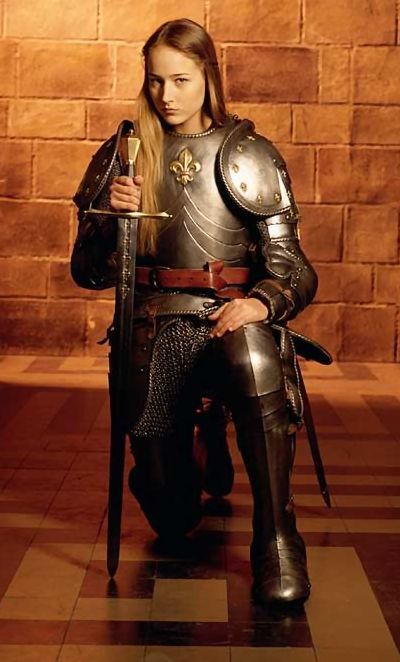
 However, the main difference between this and The Messenger is that Joan of Arc is convincing. Perhaps with the advantage of having extra time (the DVD of the miniseries runs 189 minutes), they make the effort to show her interacting with other characters, and Sobieski’s calm, complete assurance is a striking contrast to Jovovich. The viewer can see why people would believe her, and it naturally follows they will too – Sobieski’s Emmy nomination was entirely well-deserved. Despite playing fast and loose with the facts (another example: Joan’s brother was not killed in battle, but lived to see her trial verdict overturned), this strong central performance holds the film together and, with the aid of the other fine actors, makes it eminently watchable. It may not be historically accurate, but it does a fine job of explaining why her myth is still honoured in the third millennium, without coming down in one camp or the other regarding the source of her visions. There are few TV miniseries worth watching, and fewer still worth owning, but this one comes highly recommended.
However, the main difference between this and The Messenger is that Joan of Arc is convincing. Perhaps with the advantage of having extra time (the DVD of the miniseries runs 189 minutes), they make the effort to show her interacting with other characters, and Sobieski’s calm, complete assurance is a striking contrast to Jovovich. The viewer can see why people would believe her, and it naturally follows they will too – Sobieski’s Emmy nomination was entirely well-deserved. Despite playing fast and loose with the facts (another example: Joan’s brother was not killed in battle, but lived to see her trial verdict overturned), this strong central performance holds the film together and, with the aid of the other fine actors, makes it eminently watchable. It may not be historically accurate, but it does a fine job of explaining why her myth is still honoured in the third millennium, without coming down in one camp or the other regarding the source of her visions. There are few TV miniseries worth watching, and fewer still worth owning, but this one comes highly recommended.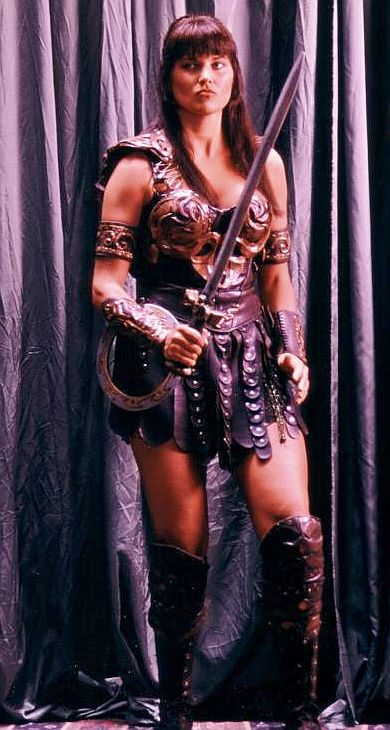
 There was enormous, often ferocious debate among fandom over the nature of Xena and Gabrielle’s relationship, some asserting they were a lesbian couple. While both showed plenty of evidence of heterosexuality, there was a lot of content open to interpretation – much of it absolutely deliberate, and known as “subtext” in Xena fandom. I never found it convincing. My issue with it was not one of sexuality, simply compatibility: Xena and Gabrielle were absolute opposites, in background, upbringing, personality and approach. They just didn’t “fit” each other, from what I could see, and there was no chemistry visible. Xena and Hercules: I could see that. Xena and the Queen of the Amazons: no problem there either. But Xena and Gabrielle? Sorry. Not buying this. It also played into the stereotype that any strong woman
There was enormous, often ferocious debate among fandom over the nature of Xena and Gabrielle’s relationship, some asserting they were a lesbian couple. While both showed plenty of evidence of heterosexuality, there was a lot of content open to interpretation – much of it absolutely deliberate, and known as “subtext” in Xena fandom. I never found it convincing. My issue with it was not one of sexuality, simply compatibility: Xena and Gabrielle were absolute opposites, in background, upbringing, personality and approach. They just didn’t “fit” each other, from what I could see, and there was no chemistry visible. Xena and Hercules: I could see that. Xena and the Queen of the Amazons: no problem there either. But Xena and Gabrielle? Sorry. Not buying this. It also played into the stereotype that any strong woman 
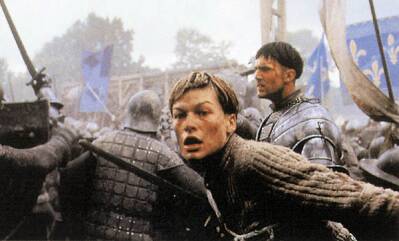 Joan’s capture, trial and execution are fairly close to the truth, though in reality, the King was less involved and more concerned for Joan than shown. It certainly is reasonable to suggest that a naive innocent such as Joan would have been used for political ends. Once she’d outlasted her usefulness – and with the king on the throne, she quickly became more a hindrance than a help – she would have needed to be disposed of. Must confess, I quite like the concept of Joan as a medieval version of Lee Harvey Oswald. Dustin Hoffman’s appearance as Joan’s conscience is another neat touch, and his sarcasm works well. Indeed, the film is one good performance from being excellent. The bad news is, it’s Jovovich who is the culprit (a messenger who deserves to be shot?), though Besson and co-writer Andrew Birkin perhaps warrant most of the criticism for twisting facts and characters in order to fit a predetermined goal. Their Joan is so far from the historical record, they’d have been better off placing their character in an entirely fictitious setting.
Joan’s capture, trial and execution are fairly close to the truth, though in reality, the King was less involved and more concerned for Joan than shown. It certainly is reasonable to suggest that a naive innocent such as Joan would have been used for political ends. Once she’d outlasted her usefulness – and with the king on the throne, she quickly became more a hindrance than a help – she would have needed to be disposed of. Must confess, I quite like the concept of Joan as a medieval version of Lee Harvey Oswald. Dustin Hoffman’s appearance as Joan’s conscience is another neat touch, and his sarcasm works well. Indeed, the film is one good performance from being excellent. The bad news is, it’s Jovovich who is the culprit (a messenger who deserves to be shot?), though Besson and co-writer Andrew Birkin perhaps warrant most of the criticism for twisting facts and characters in order to fit a predetermined goal. Their Joan is so far from the historical record, they’d have been better off placing their character in an entirely fictitious setting.